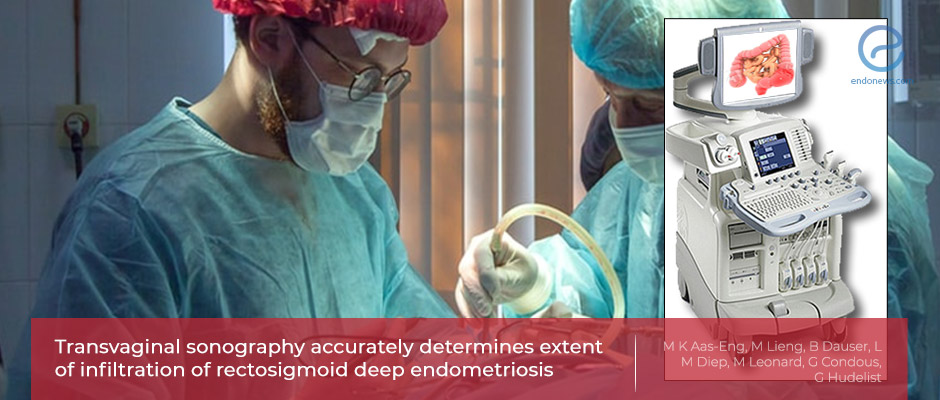How to measure the length of recto-sigmoid deep endometriosis reliably?
Sep 1, 2021
Transvaginal ultrasonography has given good results in assessing the infiltration in rectosigmoid deep endometriosis
Key Points
Highlight
- Transvaginal ultrasonography is a reliable method in the measurement of rectosigmoid deep endometriosis length.
Importance
- The correct measurement of the rectosigmoid deep endometriosis is crucial in determining the most useful surgical procedure for every individual patient.
- The older surgical method “segmental resection” has alternatives nowadays such as “discoid resection” and “shaving”.
- The determination of the extent of infiltration allows gynecologic surgeons to carefully assess and decide which method should be chosen for each patient.
Key results
- The pre-surgical measurements with transvaginal ultrasonography and post-surgical fresh bowel specimen measurements with a manual ruler were compared, and the reliability in assessing the length of the lesions was high.
- The reliability results of the thickness and transverse measurements were moderate and moderate-to-poor, respectively.
What’s done here?
- This is a multi-center study that included symptomatic patients who were eligible for a surgical procedure with a diagnosis of rectosigmoid deep endometriosis.
- The researchers aimed to identify the importance and reliability of pre-surgical usage of transvaginal ultrasonography in assessing the dimensions of the lesions.
Strength and Limitations
- The limitations were the variability in how the bowel was cut post-surgically, the usage of a manual ruler in the post-surgical measurement, the difficulty in identifying the depth of infiltration pre-surgically, the lack of bowel preparation before surgery, not sub-classifying the lesion shapes, the possible inter-and intra-observer variability in measuring the lesion sizes.
- The strength of the study was the investigation of the agreement and any in-between method differences.
Lay Summary
An in-depth assessment is needed when rectosigmoid deep endometriosis is decided to be treated surgically. Surgery carries a lot of risks and it is not always easy to decide which procedure the patient would benefit the most from. Patient-oriented surgical techniques such as discoid resection and shaving have been established as alternatives to more radical methods such as segmental resection. In the pre-surgical diagnosis of deep endometriosis, transvaginal ultrasonography has shown high specificity and sensitivity.
"The International Deep Endometriosis Analysis" which targets a better analysis of the extent of deep endometriosis and three-dimensional measurement of deep endometriosis lesions is recommended by this group. A multi-center study was designed by Aas-Eng et al. to compare the pre-surgical and post-surgical dimensions of rectosigmoid deep endometriosis lesions and the results were published in the June issue of the journal Ultrasound in Obstetrics & Gynecology.
A total of 166 women with a scheduled elective surgery for rectosigmoid endometriosis was gathered from three different centers in Norway, Austria, and Australia. The length, thickness, and transverse measurements of the lesions were performed by gynecologic surgeons pre-operatively using transvaginal ultrasonography. The performed surgical procedures were segmental and discoid resections. The post-surgical measurement of the lesions was performed on fresh bowel specimens and the endometriosis diagnosis was confirmed histopathologically.
Researchers found that the transvaginal ultrasonography measurements were reliable in determining the length of the lesions whereas they were moderately and moderate-to-poorly reliable in determining the thickness and transverse measurements of the lesions. The authors discussed the results with the limitations of the study which included the variability in the post-surgical measurement of the specimen which depended on how the bowel was cut, and the usage of a manual ruler instead of a digital one. They also stated the infiltration depth was hard to assess with transvaginal ultrasonography and it might have caused variability in the measurement of other dimensions. The shapes of the lesions were not evaluated, but the authors recommended it would be a good study subject.
The authors advise and encourage for a similar multi-center study from different centers all around the world.
Research Source: https://pubmed.ncbi.nlm.nih.gov/34182605/
deep endometriosis rectosigmoid endometriosis endometriosis surgery transvaginal ultrasonography

